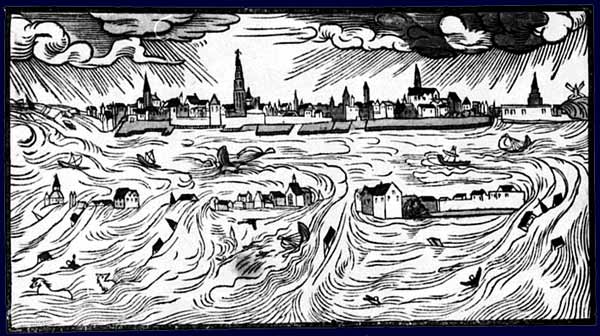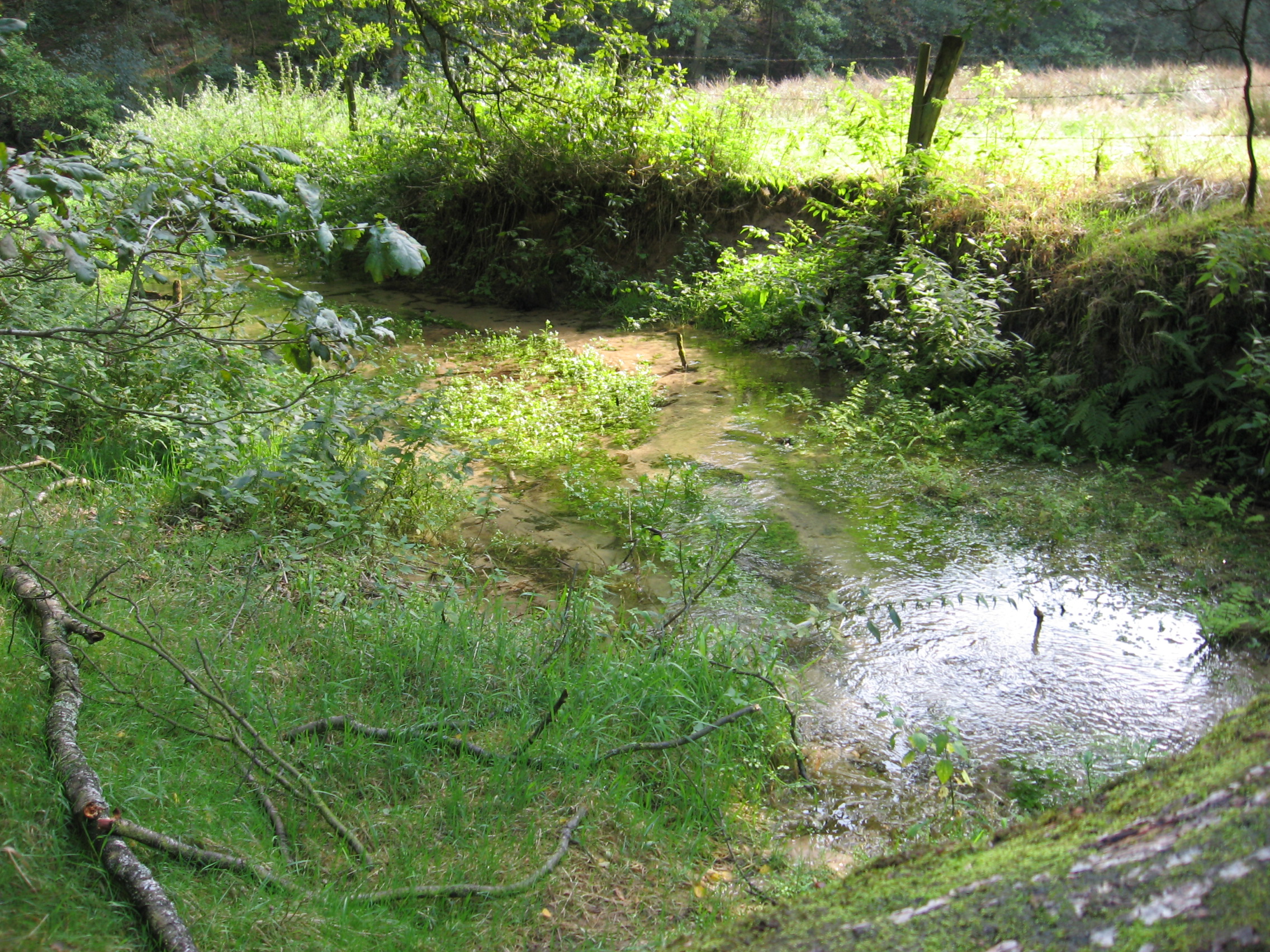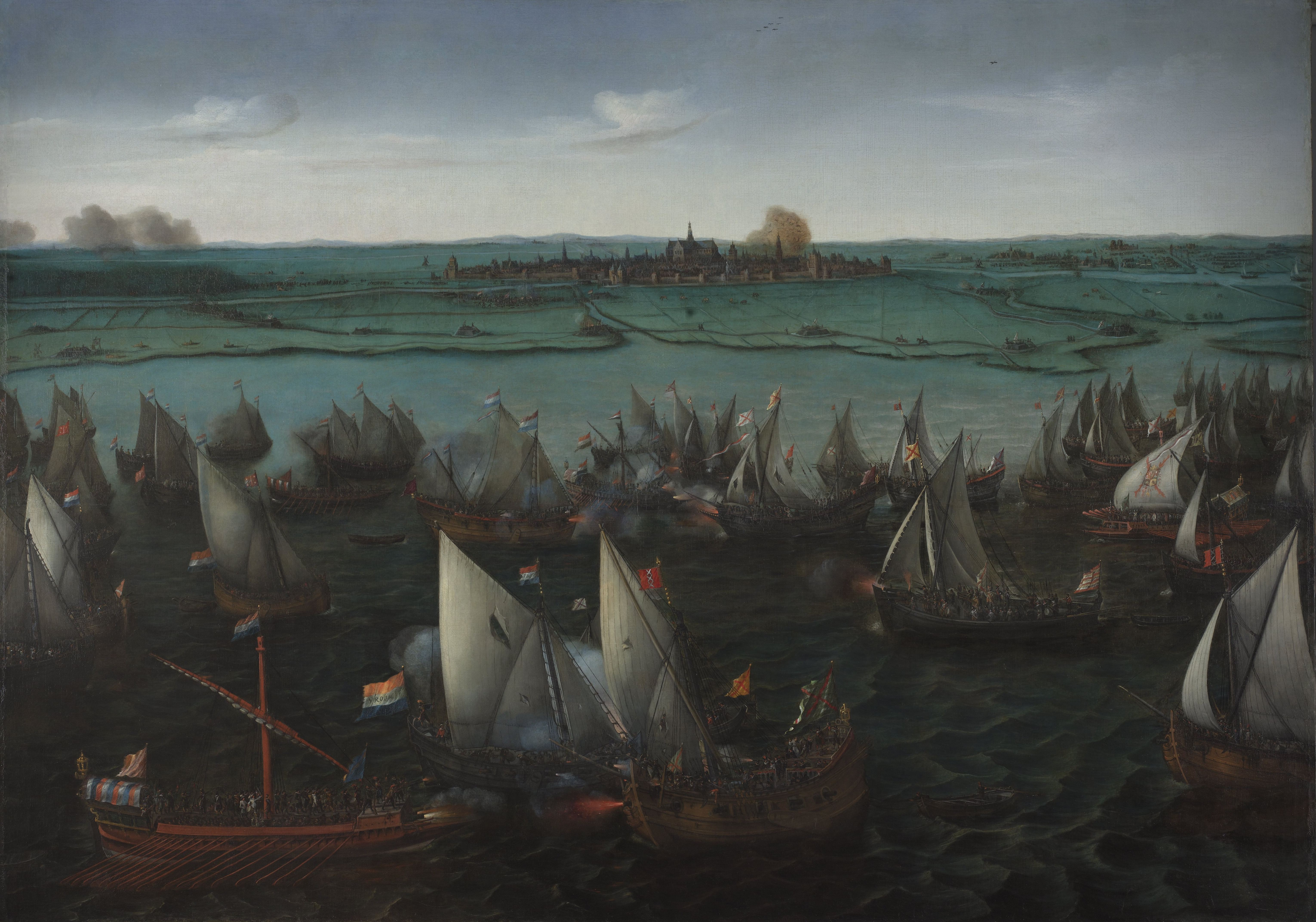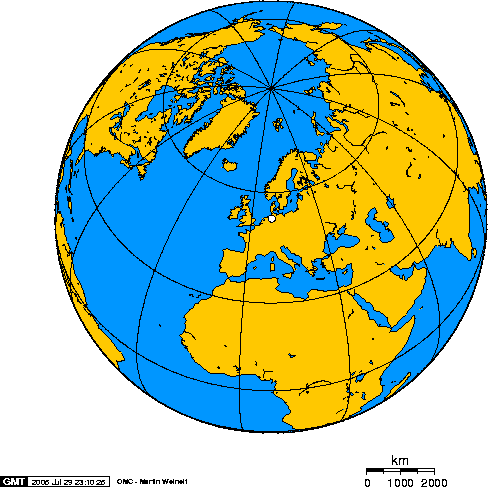|
All Saints' Flood (1570)
The All Saints' Flood of 1570 occurred on November 1–2, 1570 in the Spanish Netherlands, and is considered the worst North Sea flood disaster before the 20th century. It flooded the entire coast of the Netherlands and East Frisia. The effects were felt from Calais in Flanders to Jutland and even Norway. Even though the alleged casualty figures were mostly based on rough estimates and should be viewed with skepticism, up to 25,000 deaths can be assumed. Course of events The morning before the storm surge, a warning of a very strong flood had been issued for the first time in history. In Bergen op Zoom, the Domain Council, the local administration, had issued the warning, but it had not had the intended effect, as most victims were not reached by the warning and were caught unprepared by the flood. With a level of more than four meters above the mean high water, the flood was well above the height of the dikes existing at the time, which were also severely neglected. In numerou ... [...More Info...] [...Related Items...] OR: [Wikipedia] [Google] [Baidu] |
Spanish Netherlands
The Spanish Netherlands (; ; ; ) (historically in Spanish: , the name "Flanders" was used as a '' pars pro toto'') was the Habsburg Netherlands ruled by the Spanish branch of the Habsburgs from 1556 to 1714. They were a collection of States of the Holy Roman Empire in the Low Countries held in personal union by the Spanish Crown. This region comprised most of the modern states of Belgium and Luxembourg, as well as parts of northern France, the southern Netherlands, and western Germany, with the capital being Brussels. The Army of Flanders was given the task of defending the territory. The Imperial fiefs of the former Burgundian Netherlands had been inherited by the Austrian House of Habsburg from the extinct House of Valois-Burgundy upon the death of Mary of Burgundy in 1482. The Seventeen Provinces formed the core of the Habsburg Netherlands, which passed to the Spanish Habsburgs upon the abdication of Emperor Charles V in 1556. When part of the Netherlands separated to ... [...More Info...] [...Related Items...] OR: [Wikipedia] [Google] [Baidu] |
Ems (river)
The Ems ( ; ) is a river in northwestern Germany. It runs through the states of North Rhine-Westphalia and Lower Saxony, and discharges into the Dollart Bay which is part of the Wadden Sea. Its total length is . The state border between the Lower Saxon area of East Friesland (Germany) and the province of Groningen (Netherlands), whose exact course was the subject of a border dispute between Germany and the Netherlands (settled in 2014), runs through the Ems estuary. Course The source of the river is in the southern Teutoburg Forest in North Rhine-Westphalia. In Lower Saxony, the brook becomes a comparatively large river. Here the swampy region of Emsland is named after the river. In Meppen the Ems is joined by its largest tributary, the Hase River. It then flows northwards, close to the Dutch border, into East Frisia. Near Emden, it flows into the Dollard bay (a national park) and then continues as a tidal river towards the Dutch city of Delfzijl. Between Emden and Delf ... [...More Info...] [...Related Items...] OR: [Wikipedia] [Google] [Baidu] |
European Windstorms
European windstorms are powerful extratropical cyclones which form as cyclone, cyclonic windstorms associated with areas of low atmospheric pressure. They can occur throughout the year, but are most frequent between October and March, with peak intensity in the winter months. Deep areas of low pressure are common over the North Atlantic, and occasionally start as nor'easters off the New England coast. They frequently track across the North Atlantic Ocean towards the north of Scotland and into the Norwegian Sea, which generally minimizes the impact to inland areas; however, if the track is further south, it may cause adverse weather conditions across Central Europe, Northern Europe and especially Western Europe. The countries most commonly affected include the United Kingdom, Republic of Ireland, Ireland, the Netherlands, Norway, Germany, the Faroe Islands and Iceland. The strong wind phenomena intrinsic to European windstorms, that give rise to "damage footprints" at the surface ... [...More Info...] [...Related Items...] OR: [Wikipedia] [Google] [Baidu] |
1570 In The Habsburg Netherlands
Year 157 ( CLVII) was a common year starting on Friday of the Julian calendar. At the time, it was known as the Year of the Consulship of Civica and Aquillus (or, less frequently, year 910 ''Ab urbe condita''). The denomination 157 for this year has been used since the early medieval period, when the Anno Domini calendar era became the prevalent method in Europe for naming years. Events By place Roman Empire *A revolt against Roman rule begins in Dacia. Births * Gaius Caesonius Macer Rufinianus, Roman politician (d. 237) * Hua Xin, Chinese official and minister (d. 232) * Liu Yao, Chinese governor and warlord (d. 198) * Xun You, Chinese official and statesman (d. 214 Year 214 ( CCXIV) was a common year starting on Saturday of the Julian calendar. At the time, it was known as the Year of the Consulship of Messalla and Suetrius (or, less frequently, year 967 ''Ab urbe condita''). The denomination 214 for this ...) Deaths References {{DEFAULTSORT:157 [...More Info...] [...Related Items...] OR: [Wikipedia] [Google] [Baidu] |
16th-century Floods
The 16th century began with the Julian calendar, Julian year 1501 (represented by the Roman numerals MDI) and ended with either the Julian or the Gregorian calendar, Gregorian year 1600 (MDC), depending on the reckoning used (the Gregorian calendar introduced a lapse of 10 days in October 1582). The Renaissance in Italy and Europe saw the emergence of important artists, authors and scientists, and led to the foundation of important subjects which include accounting and political science. Copernicus proposed the Copernican heliocentrism, heliocentric universe, which was met with strong resistance, and Tycho Brahe refuted the theory of celestial spheres through observational measurement of the SN 1572, 1572 appearance of a Milky Way supernova. These events directly challenged the long-held notion of an immutable universe supported by Ptolemy and Aristotle, and led to major revolutions in astronomy and science. Galileo Galilei became a champion of the new sciences, invented the first ... [...More Info...] [...Related Items...] OR: [Wikipedia] [Google] [Baidu] |
Saeftinghe Legend
The Saeftinghe Legend is an old Dutch folk tale that explains the sunken city of Saeftinghe in eastern Zeelandic Flanders near Nieuw-Namen, The Netherlands, that existed until it was entirely flooded by sea waters in 1584. The legends says the city grew to be the most prosperous city on the fertile lands of the Scheldts but the inhabitants grew vain and proud. The farmers dressed in silk, their horses wearing silver and even the thresholds of homes were made from gold. The wealth attracted poor immigrants but the people of Saeftinghe showed no mercy and chased the migrants away with sticks and dogs. Greed corrupted the hearts of men and turned them blind for imminent threats. On a foggy day, a fisherman caught a mermaid on the waters of the Western Scheldt. From the nets, the mermaid warned him Saeftinghe needed to change its ways or suffer the inevitable dire consequences. When the mermaid's husband surfaced and asked for his wife to be set free, the fisherman refused and yelled ... [...More Info...] [...Related Items...] OR: [Wikipedia] [Google] [Baidu] |
Floods In The Netherlands
This is a chronological list of sea-floods that have occurred in the Netherlands. In addition to these there have been hundreds of river floods during the centuries. See also *Flood control in the Netherlands References External links Christmas Day flood 1717 map {{Webarchive, url=https://web.archive.org/web/20181209030333/http://www.livius.org/opinion/opinion0008.html , date=2018-12-09 Medieval weather events |
Holland
Holland is a geographical regionG. Geerts & H. Heestermans, 1981, ''Groot Woordenboek der Nederlandse Taal. Deel I'', Van Dale Lexicografie, Utrecht, p 1105 and former provinces of the Netherlands, province on the western coast of the Netherlands. From the 10th to the 16th century, Holland proper was a unified political region within the Holy Roman Empire as a county ruled by the counts of Holland. By the 17th century, the province of Holland had risen to become a maritime and economic power, dominating the other provinces of the newly independent Dutch Republic. The area of the former County of Holland roughly coincides with the two current Provinces of the Netherlands, Dutch provinces of North Holland and South Holland into which it was divided, and which together include the Netherlands' three largest cities: the Capital of the Netherlands, capital city (Amsterdam), the home of Port of Rotterdam, Europe's largest port (Rotterdam), and the seat of government (The Hague). Hollan ... [...More Info...] [...Related Items...] OR: [Wikipedia] [Google] [Baidu] |
Geuzen
''Geuzen'' (; ; ) was a name assumed by the confederacy of Calvinist Dutch nobles, who from 1566 opposed Spanish rule in the Netherlands. The most successful group of them operated at sea, and so were called ''Watergeuzen'' (; ; ). In the Eighty Years' War, the Capture of Brielle by the ''Watergeuzen'' in 1572 provided the first foothold on land for the rebels, who would conquer the northern Netherlands and establish an independent Dutch Republic. They can be considered either as privateers or pirates, depending on the circumstances or motivations. Origin of the name The leaders of the nobles who signed a solemn league known as the Compromise of Nobles, by which they bound themselves to assist in defending the rights and liberties of the Netherlands against the civil and religious despotism of Philip II of Spain, were Louis of Nassau and Hendrick van Brederode. On 5 April 1566, permission was obtained for the confederates to present a petition of grievances, called the R ... [...More Info...] [...Related Items...] OR: [Wikipedia] [Google] [Baidu] |
Weser
The Weser () is a river of Lower Saxony in north-west Germany. It begins at Hannoversch Münden through the confluence of the Werra and Fulda. It passes through the Hanseatic city of Bremen. Its mouth is further north against the ports of Bremerhaven and Nordenham. The latter is on the Butjadingen Peninsula. It then merges into the North Sea The North Sea lies between Great Britain, Denmark, Norway, Germany, the Netherlands, Belgium, and France. A sea on the European continental shelf, it connects to the Atlantic Ocean through the English Channel in the south and the Norwegian Se ... via two highly Saline water, saline, Estuary, estuarine mouths. It connects to the canal network running east–west across the North German Plain. The river, when combined with the Werra (a dialectal form of ''Weser''), is long and thus, the longest river entirely situated within Germany (the Main (river), Main, however, is the longest if the Weser-Werra are considered separate). ... [...More Info...] [...Related Items...] OR: [Wikipedia] [Google] [Baidu] |





